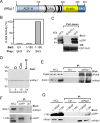PakB binds to the SH3 domain of Dictyostelium Abp1 and regulates its effects on cell polarity and early development
- PMID: 23699396
- PMCID: PMC3708727
- DOI: 10.1091/mbc.E12-12-0883
PakB binds to the SH3 domain of Dictyostelium Abp1 and regulates its effects on cell polarity and early development
Abstract
Dictyostelium p21-activated kinase B (PakB) phosphorylates and activates class I myosins. PakB colocalizes with myosin I to actin-rich regions of the cell, including macropinocytic and phagocytic cups and the leading edge of migrating cells. Here we show that residues 1-180 mediate the cellular localization of PakB. Yeast two-hybrid and pull-down experiments identify two proline-rich motifs in PakB-1-180 that directly interact with the SH3 domain of Dictyostelium actin-binding protein 1 (dAbp1). dAbp1 colocalizes with PakB to actin-rich regions in the cell. The loss of dAbp1 does not affect the cellular distribution of PakB, whereas the loss of PakB causes dAbp1 to adopt a diffuse cytosolic distribution. Cosedimentation studies show that the N-terminal region of PakB (residues 1-70) binds directly to actin filaments, whereas dAbp1 exhibits only a low affinity for filamentous actin. PakB-1-180 significantly enhances the binding of dAbp1 to actin filaments. When overexpressed in PakB-null cells, dAbp1 completely blocks early development at the aggregation stage, prevents cell polarization, and significantly reduces chemotaxis rates. The inhibitory effects are abrogated by the introduction of a function-blocking mutation into the dAbp1 SH3 domain. We conclude that PakB plays a critical role in regulating the cellular functions of dAbp1, which are mediated largely by its SH3 domain.
Figures








Similar articles
-
Abp1 regulates pseudopodium number in chemotaxing Dictyostelium cells.J Cell Sci. 2006 Feb 15;119(Pt 4):702-10. doi: 10.1242/jcs.02742. Epub 2006 Jan 31. J Cell Sci. 2006. PMID: 16449327
-
A myosin IK-Abp1-PakB circuit acts as a switch to regulate phagocytosis efficiency.Mol Biol Cell. 2010 May 1;21(9):1505-18. doi: 10.1091/mbc.e09-06-0485. Epub 2010 Mar 3. Mol Biol Cell. 2010. PMID: 20200225 Free PMC article.
-
Cellular distribution and functions of wild-type and constitutively activated Dictyostelium PakB.Mol Biol Cell. 2005 Jan;16(1):238-47. doi: 10.1091/mbc.e04-06-0534. Epub 2004 Oct 27. Mol Biol Cell. 2005. PMID: 15509655 Free PMC article.
-
Trafficking and developmental signaling: Alix at the crossroads.Eur J Cell Biol. 2006 Sep;85(9-10):925-36. doi: 10.1016/j.ejcb.2006.04.002. Eur J Cell Biol. 2006. PMID: 16766083 Review.
-
Regulation of Dictyostelium myosin I and II.Biochim Biophys Acta. 2001 Mar 15;1525(3):245-61. doi: 10.1016/s0304-4165(01)00110-6. Biochim Biophys Acta. 2001. PMID: 11257438 Review.
Cited by
-
SILAC-based proteomic quantification of chemoattractant-induced cytoskeleton dynamics on a second to minute timescale.Nat Commun. 2014 Feb 26;5:3319. doi: 10.1038/ncomms4319. Nat Commun. 2014. PMID: 24569529 Free PMC article.
-
Regulation of the Actin Cytoskeleton via Rho GTPase Signalling in Dictyostelium and Mammalian Cells: A Parallel Slalom.Cells. 2021 Jun 24;10(7):1592. doi: 10.3390/cells10071592. Cells. 2021. PMID: 34202767 Free PMC article. Review.
-
Cdc42/Rac Interactive Binding Containing Effector Proteins in Unicellular Protozoans With Reference to Human Host: Locks of the Rho Signaling.Front Genet. 2022 Feb 2;13:781885. doi: 10.3389/fgene.2022.781885. eCollection 2022. Front Genet. 2022. PMID: 35186026 Free PMC article. Review.
References
-
- Bement WM, Mooseker MS. TEDS rule: a molecular rationale for differential regulation of myosins by phosphorylation of the heavy chain head. Cell Motil Cytoskeleton. 1995;31:87–92. - PubMed
Publication types
MeSH terms
Substances
Grants and funding
LinkOut - more resources
Full Text Sources
Other Literature Sources
Molecular Biology Databases
Research Materials
Miscellaneous

